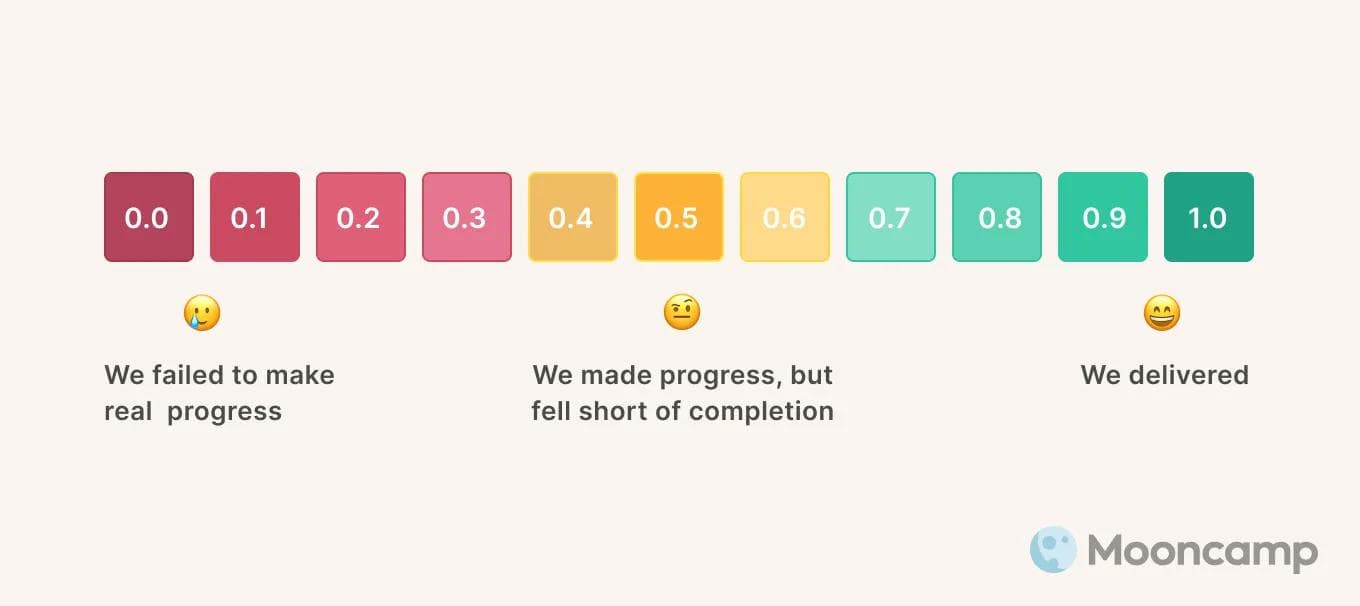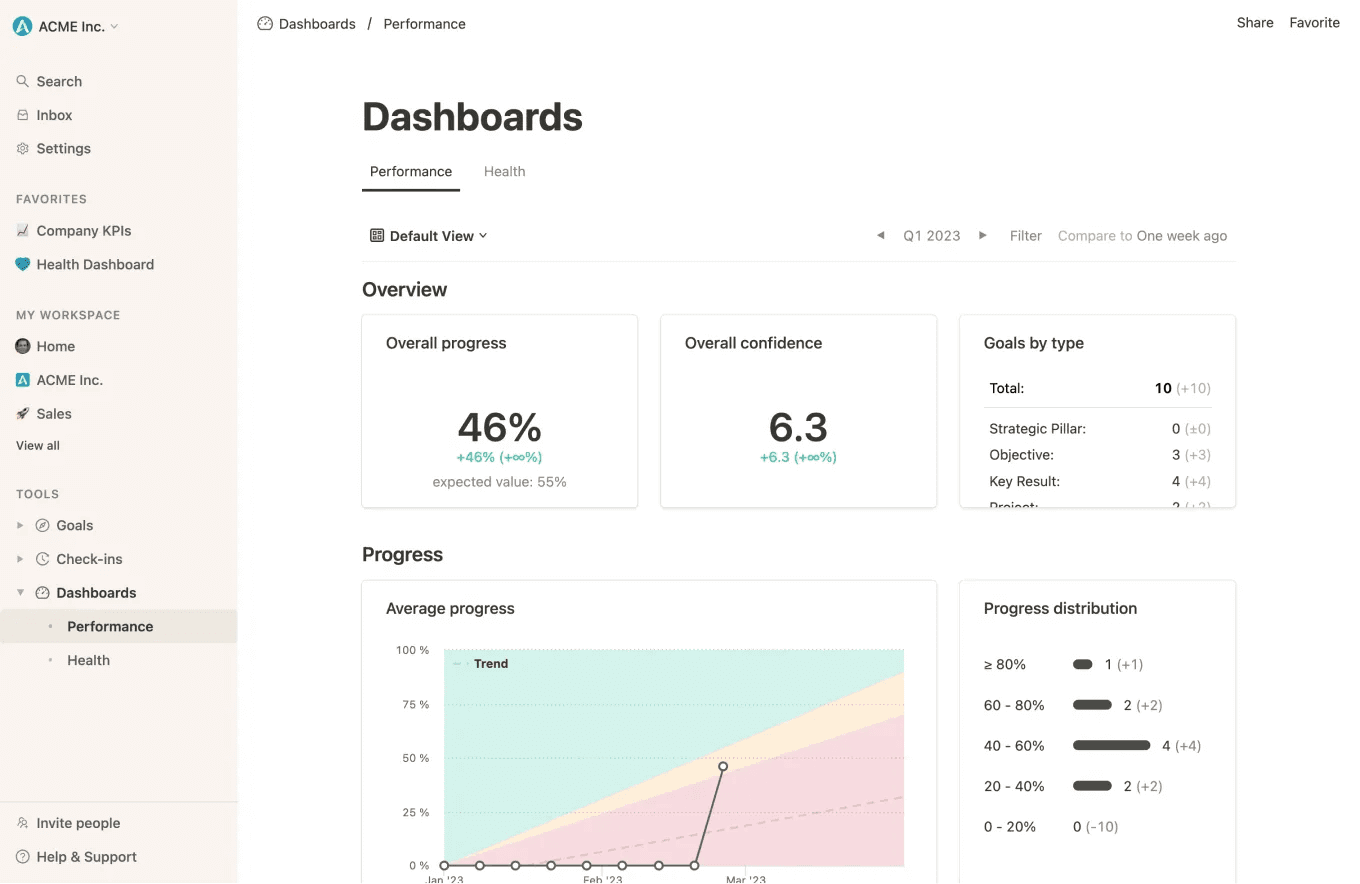OKR scoring: How to score OKRs [scale + tips]

At the end of an OKR cycle, it is time to reflect on the current OKRs. Were the goals actually met? What needs to improve in the next cycle? OKR scoring provides the data for this. This article explains what is important for this process. It also reveals helpful tips and best practices for an effective OKR scoring process.
What to expect:
- What is OKR scoring or OKR grading?
- Why OKR scoring? Goal and benefits
- How does OKR scoring work?
- 5 tips for effective OKR scoring
- OKR scoring: FAQ
What is OKR scoring?
OKR scoring (or OKR grading) is the final evaluation of OKRs at the end of each OKR cycle. OKR scoring therefore refers to a final "grade" that expresses the extent to which the OKRs have been achieved. At the same time, it also assesses how successful the implemented initiatives and measures were during the cycle. The assessment is always based on clear metrics, benchmarks and criteria that are defined with the Key Results at the beginning of the OKR cycle.
💡 Tip: Before OKRs can be assessed, they must be written and implemented. For those who want a quick refresher on the fundamentals, here is
- an OKR guide with all the basics,
- tips for good Objectives and Key Results,
- over 40 OKR examples from real companies and
- a complete guide on how to implement and scale OKRs.
Why OKR Scoring? Goal and benefits
The main purpose of OKR scoring is to reflect on achievements and, if necessary, to identify what should be done differently in the next cycle. It serves as a source of data for the OKR review, which assesses and analyzes why OKRs were or were not achieved.
Scores can also provide valuable insights for reflecting on the process in the OKR retrospective. Problems become more easily visible based on the data and can be addressed in the next cycle.
Additionally, a final evaluation of the OKR helps ensure that the entire team stays on track and that the OKRs are not lost in the day-to-day business.
How does OKR scoring work?
To score OKRs in a meaningful way, one needs
- a scale on which the results are measured,
- a scoring key that specifies which criteria correspond to which score, and
- a clear idea of what defines success.
In general, Objectives and Key Results are evaluated separately. Key Results are assessed first. The overall score of the OKRs can then be derived from the Key Results’ scores. Objectives are also reviewed carefully through the yes/no principle.
💡 Important: Unlike committed OKRs, aspirational OKRs should not be too easy to achieve. A good rule of thumb for evaluation is that if you achieve 70 percent of what you set out to do, you have already succeeded.
Score Key Results
The simplest evaluation method (according to Andy Grove) would be a binary scoring method with a simple "yes" or "no" answer to whether a Key Result was achieved. However, since answering "yes" or "no" is not as simple in practice, Google established a different approach which rates Key Results on a scale from 0.0 to 1.0.
A score of 0.0 means that no progress has been made, while 1.0 indicates that the goals have been completely reached or exceeded. The scores on the scale can also be grouped and visualized according to the traffic light system (green, yellow, red) or with emojis (laughing, neutral, sad). This makes success (or failure) more visible. Alternatively, one can simplify the scale even further by only using colors and emojis.
- 0.7 to 1.0: Green = We delivered.
- 0.4 to 0.6: Yellow = We have made progress, but fell short of completion.
- 0.0 to 0.3: Red = We failed to make any real progress.

To truly measure progress and not just estimate it, the exact OKR grading scale for each Key Result should be defined at the beginning of the OKR cycle. For example, if a Key Result is "We increase the organic traffic of our website by 150%", the grading could be:
- 0% increase = 0.0
- 15 % increase = 0.1
- 75% increase = 0.5
- 105 % increase =0.7
- ≥ 150 % increase = 1.0
Score Objectives
There are several ways to assess whether or to what extent an Objective has been achieved. For the most part, it is determined through the scores of the Key Results. Thus, there is no separate scoring key for the Objective. Only Key Results are scored.
In order to determine the overall OKR score, a rough average is calculated from the scores of the individual Key Results. For each Objective, the scores of the corresponding Key Results are added and divided by their number. The individual Key Results can also be weighted differently – depending on how much they contribute to the Objective.
Example:
The Objective is to increase customer satisfaction.
It has 3 Key Results, which are evaluated after one cycle as follows:
- Increase number of positive reviews by 20%; score = 0.7
- Reduce number of complaints by 10%; score = 0.6
- Reduce average response time by 15%; Score = 0.9
For the overall evaluation, the rough average of the three scores is calculated:
(0.8 + 0.6 + 0.9)/3 = 0.77
In this example, 77 percent of the Objective "Increase customer satisfaction" was completed. Therefore, it can be considered to have been successfully implemented.
Important: The overall score derived from the Key Results should not be taken at face value. Instead, the score should always be critically examined (following Andy Grove's example) according to the yes/no principle:
- Does the score correspond to reality?
- Was Objective really achieved? Yes or no?
- Did the Key Results perhaps measure something else?
After all, sometimes the question “Has the Objective really been achieved?” can be answered with “Yes”, despite the Key Results not having been fulfilled – and vice versa. In this case, the scoring would be an indicator for poorly chosen Key Results.
OKR scoring vs. confidence level
To ensure a favorable OKR scoring at the end of the cycle, the (potential) achievement level of the OKRs should already be examined during the cycle. For this purpose, the so-called confidence level (or confidence score) is estimated in weekly OKR check-ins. This expresses how confident the team is that the Key Results will actually be achieved at the end of the current cycle.
Usually, this is done with a simple three-level scale (for more on this, see the article on OKR Check-ins). However, the confidence level can also be broken down in more detail on a scale from 0 to 10 (or 0.0 to 1.0). This makes it similar to OKR scoring at first glance, but there is an important difference:
- The confidence level is an estimate of how likely it is to achieve the OKRs. Initiatives are then prioritized and adjusted accordingly.
- At the end of the cycle the OKR scoring or OKR grading determines to what extent the OKRs have actually been completed. This ensures final feedback that helps evaluate success (or failure) and improve the process in the next cycle, if necessary.
At the beginning of the cycle, the confidence score should be around 50 percent (0.5 or 5/10). The more initiatives implemented, the more confident the score should become. The OKRs are then "on track." However, if obstacles are encountered and confidence drops, new initiatives should be implemented in order to change the course of action.
💡 Tip: As the OKR cycle progresses, the confidence level becomes less relevant. Shortly before the end of the cycle, the OKR assessment should ideally be predictable enough to allow a preliminary OKR score, which only needs to be finalized before the OKR review. Likewise, consistent confidence scoring during the cycle can also make the final grading redundant. It is therefore best to experiment a bit and omit OKR scoring if it does not provide new insights.
5 tips for effective OKR scoring.
OKRs are always unique to the team and the company. The scoring should be just as individual. That said, there are some general tips and best practices that can make OKR scoring easier:
- Set scoring criteria early on: The scale in which the Key Results will later be scored should already be considered in the OKR planning and written alongside the Key Results.
- Publish results: OKR scoring should be visible to all teams and employees in the company. This provides transparency and can motivate.
- Create an OKR scoring template: A template helps visualize the scores clearly. This process combines tracking and scoring. For example, our Google Sheets Tracking Template provides columns to enter scoring and highlight progress in color.
- Score honestly: OKR scoring is not a performance evaluation. It is not all about highscores. Therefore, one should not be afraid of low-scoring OKRs. Instead they should be seen as opportunities for learning and reflected upon openly. The scores’ interpretation can also range from “Nothing learnt” (0.0) to “Learned a lot” (0.6 to 0.7) to “Achieved, but was the goal unambitious?” (1.0).
- Use OKR software: Especially for larger teams and companies, it is usually easier and clearer to track all progress in an OKR software.

OKR scoring: FAQ
What is OKR grading?
OKR grading can be used synonymously with OKR scoring. Both terms describe the same process: the final evaluation of OKRs at the end of each OKR cycle.
How are OKRs calculated?
Only Key Results are measured, not Objectives. Each Key Result is usually rated at the end of the OKR cycle on a scale from 0.0 to 1.0, with 0.0 representing "no progress" and 1.0 representing "completion." The criteria and metrics used to determine the grading are clearly defined for each Key Result. The overall OKR score is derived from the average scores of the respective Key Results and their comparison with the yes/no answer to the question “Did we really meet the Objective?”.
Are OKRs performance metrics?
OKR scoring should not be used to assess the performance of the company or employees. Instead, it should be used to uncover problems and identify areas for improvement. OKRs should serve as inspiration and motivate employees to contribute to the company's success. Using them as performance metrics, on the other hand, is demotivating and ineffective.

